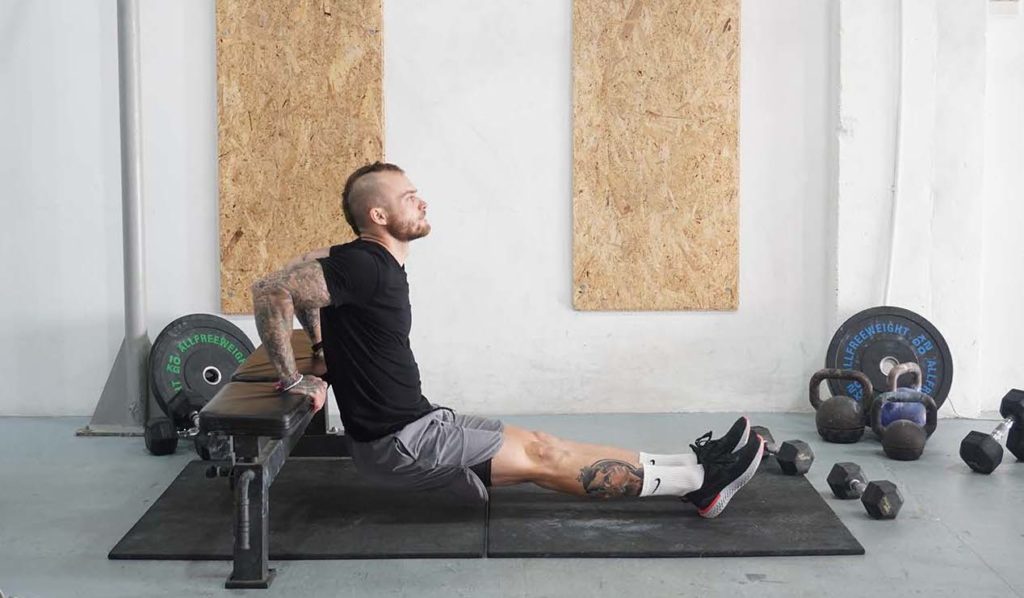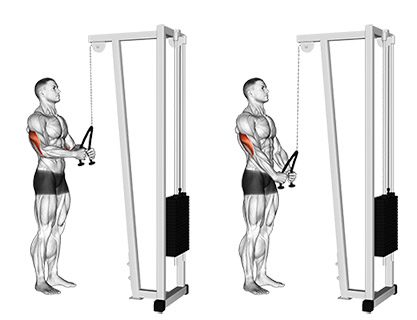The Benefits of the TRX Tricep Extension (Suspension)
Traditional tricep exercises leverage external weights: cable machines, dumbbells, straight bars, etc. In contrast, your body provides the resistance necessary for growth and strength gain during the TRX tricep extension. The objective is to use a TRX suspension trainer by grabbing the handles, leaning forward, and supporting yourself with your triceps. Once in position, lower yourself by bending your elbows, hold the bottom position for a moment, and engage your triceps to straighten your arms.
The TRX suspension trainer is a simple rope system with handles you can attach to a wall or another sturdy object. Aside from using it to perform triceps extensions, you can do inverted rows and many other suspension exercises collectively referred to as TRX training.
Unlike traditional extensions, those you perform on a suspension system are a calisthenics exercise and require more strength, so we recommend including them earlier in your training and doing as many slow and controlled repetitions as possible.
Level of Exercise: Intermediate/Advanced
How to do TRX Tricep Extension

- Attach the TRX or other suspension system overhead, having the handles hanging at chest level or slightly lower. Experiment to see what height allows you to set up in the best way.
- Stand in front of the handles and grab them with your palms facing down.
- Engage your abs, squeeze your glutes, take a breath and lean forward, lifting your heels off the floor. Keep your elbows straight.
- Take another breath and lower yourself slowly by bending your elbows.
- Go down until your elbows are at a 90-degree angle (to the point where your wrists are above your elbows). Hold the position for a moment.
- Extend your arms by engaging your triceps and bring yourself to the starting position as you exhale.
What muscles does the TRX tricep extension activate?
The primary muscle that works during suspension extensions is the triceps. Our triceps cover the rear of the upper arms and produce elbow extension, which occurs off the bottom position (1). The triceps also work to control us as we bend our elbows. Plus, the muscle provides arm stability because the long tricep head crosses the shoulder joint.
Our deltoids (shoulders) are the second muscle group in the TRX tricep extension. Their primary role is to flex isometrically and provide shoulder stability.
The entire core activates, offering torso support and keeping us rigid during the exercise. Core muscles include the rectus and transverse abdominis, internal and external obliques, erector spinae, hip flexors, and gluteus maximus.
TRX Tricep Extension vs. Dumbbell Tricep Extension
Performing tricep exercises with dumbbells, cables, or a suspension trainer is similar because all movement variations strengthen and develop the triceps.
The primary difference between TRX suspension triceps extensions and those you perform with a dumbbell or cable machine is the level of difficulty. Doing extensions with a dumbbell can be uncomfortable, and you will feel a burning sensation in your triceps. But doing the same movement on a suspension trainer is much more difficult. For one, your triceps have to work extra hard because the resistance is much greater. Second, your stabilizing muscles engage more to keep you in position.

Because of their difficulty, suspension extensions are more of a compound exercise rather than one that only targets your triceps, which is why we recommend doing them early in your training. In contrast, dumbbell extensions are easier to manage, and you can include them late in your workouts, even as the last exercise.
TRX tricep extensions also carry a slightly higher injury risk than dumbbell or cable variations. You have to be careful, brace your core, and keep your shoulders stable to stay safe.
Variations and Modifications of the TRX Triceps Extension
1. Slow Negative TRX Tricep Extension
Slow negative suspension extensions are a beginner-friendly variation you can perform to build tricep extension strength and work up to the entire exercise. The objective is to assume the starting position and bend your elbows as slowly as you can, controlling your body on the way down. Then, stand up, set up for the starting position again, and lower yourself.
2. Pause TRX Tricep Extension
Pause extensions are a neat variation you can perform to make each repetition slightly more challenging without changing anything else. The objective is to lower yourself, hold the bottom position for two to four seconds, and extend your elbows, bringing yourself to the top.
3. Single-Arm TRX Tricep Extension
The single-arm suspension extension is straightforward but incredibly challenging to pull off and only suitable for the most advanced trainees. You have to grab one handle and keep your free arm to your side or behind your back. From there, lower yourself as you usually would and extend your elbow to get back to the top. You can lean forward less or more to adjust your body position and the difficulty.
Mistakes to Avoid
Soft Midsection
One of the most common roadblocks to proper form with the TRX tricep extension is failing to engage your midsection. Doing so leads to instability, prevents you from doing the exercise effectively, and increases the risk of spine stress. Avoid the mistake by tucking your hips slightly as you engage your abs and maintaining the rigidity until you finish the set.
Flaring Your Elbows
Flaring your elbows is a common mistake with most tricep extension variations, and things are no different when doing the movement on a suspension trainer. Doing so isn’t necessarily fatal, but it shifts the emphasis to your shoulders and could increase the stress on these joints. Fix the error by consciously keeping your elbows in and close to your head from start to finish.
Shortening the Range of Motion
The third common mistake with TRX tricep extensions is shortening the range of motion. Doing so isn’t dangerous, but it makes each repetition less effective because you’re not stretching or contracting your triceps as well as you otherwise could. Avoid the error by lowering yourself until your elbows are bent and following up with full arm extension. Do regular extensions, push-ups, and other tricep movements to build strength if you can’t do suspension extensions correctly.
Similar Exercises to the TRX Triceps Extension
Bench Dip

Bench dips are a fantastic exercise that strengthens and develops your triceps, shoulders, and midsection, similar to TRX tricep extensions. The objective is to face away from a gym bench or chair, place your hands on the edge, and extend your body, supporting yourself on your arms. Once in position, take a breath and bend your elbows to lower yourself. Hold the bottom position for a moment and contract your triceps to move back to the top.
Diamond Push Up
Diamond push ups are another effective bodyweight exercise you can perform for triceps growth and strength (2). The objective is to place your hands close to one another, forming a diamond shape between your thumbs and index fingers. Having your hands close forces your triceps to do most of the work because the pectoralis major is at a mechanical disadvantage.
Triceps Rope Pushdown

Triceps rope pushdowns are a variation of the TRX triceps extension that offers many of the same benefits. The movement emphasizes your triceps, but it requires much less core stability to perform. Plus, you can adjust the resistance to fit your current strength capacity and gradually increase the load as you get stronger.

